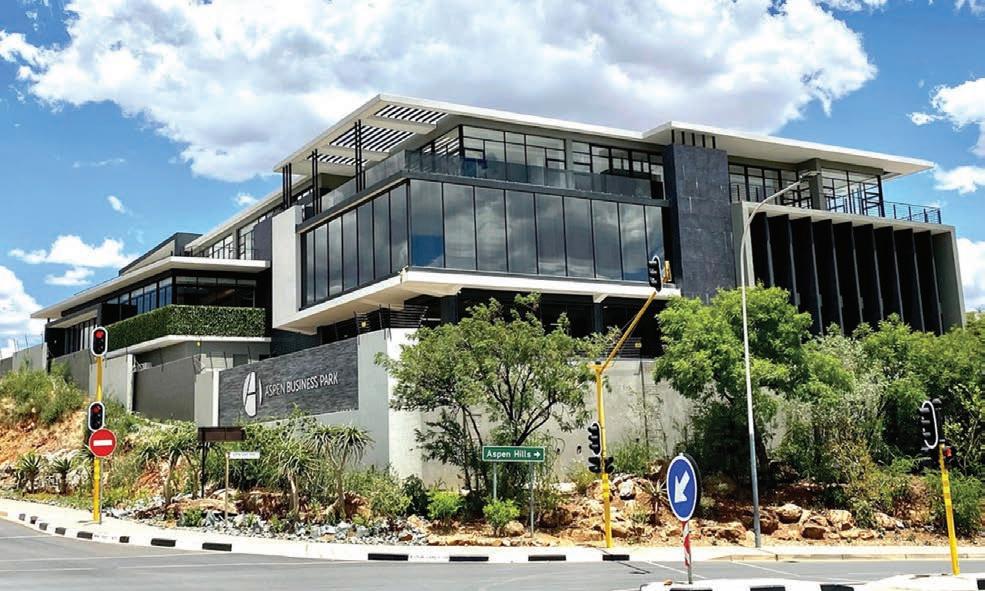
3 minute read
BUSINESS PARKS
FROM PARK TO PRECINCT
Recent trends in business park development indicate a swing to business precincts with an integrated offering, GARETH GRIFFITHS finds out more
Aspen Business Park, Johannesburg

Business park development needs to be future-looking and responsive to the changing business world, says Michael Stylianou, CEO of the Dimension Property Group.
“Our Aspen Business Park offers futuristic, sophisticated and elegant designs that complement the ever-evolving South African business community. The park is on prime land in the south of Johannesburg, 10km from the city centre, close to the Johannesburg CBD, Alberton and the northern suburbs of Johannesburg freeways. Aspen is in the beautiful Klipriviersberg Nature Reserve region and is close to another Dimension Property Group development, Aspen Nature Estate, offering nearby residential opportunities.
“Construction is well underway on our second phase. Amenities include comprehensive security features and abundant secure parking spaces for staff and visitors. We have placed great emphasis on landscaping and greening, which makes this a beautiful and stimulating place to work and visit on business,” Stylianou concludes.
THE ARCHITECTS TAKE
Guy Briggs, partner and head of urban design for dhk Architects, shares his thoughts on design trends. “We have to consider trends in office and workplace design in general. Currently, the most apparent trend is to occupy office space as little as possible! While this trend is in line with the pandemic, it may be temporary. The last ten months have revealed how much we can do remotely from home, but have also highlighted the limitations. These include the logistical difficulties of carving out a workspace, a growing sense of isolation, fewer opportunities for meaningful collaboration, and a loss of team effectiveness. In contrast, office spaces need to emphasise opportunities for engagement and interaction, notwithstanding social distancing, and reduce the focus on dedicated individual workspace if concentrated individual work can be better accomplished at home.”
Briggs explains that the original office park concept suggested a stand-alone office development, usually on the urban fringes, accessible only by car.
This is a hangover from the zonal land use planning of the 20th century.
So what does this mean for the 21st century office park?
Briggs says that the “office park” needs to be reconfigured as an “office precinct”, that is: • located centrally rather than peripherally • integrated into the surrounding urban environment • inclusive of other uses – effectively creating a mixed-use environment • provide a diversity of workspaces – ifferent office types for different business types • provides access to or includes services and amenities – shopping, restaurants, places of worship, parks and public spaces. “In short, the design of an office precinct needs to reject the sterility of 20th century spatial planning and embrace the complexity of the city,” says Briggs.
BALANCE AND LOCATION TOP PRIORITIES
Nicholas Stopforth, managing director of Amdec Property Developments – the developer behind Melrose Arch in Johannesburg – agrees, adding that companies are now looking at their employees holistically: “They don’t want their staff just to have better work lives, they want them to have better lives overall. Less time spent in traffic, more time with their families, and a work environment that not only delivers quality desktime, but also quality downtime away from the desk.
“One of the many features that make new urban precincts vibrant after hours is the balance they create between nature and the built environment. Along with greenery and urban landscaping, there are public squares and walkable precincts where people can relax and gather, free of traffic and exhaust fumes.”
Location of a new precinct is also key to business. “We chose the site for our upcoming Harbour Arch development in the Cape Town CBD because it lies at the confluence of the N1 and N2 highways, offering good access to public transportation depots downtown. Another example is our Yacht Club development located in the Roggebaai canal precinct adjacent to the Waterfront and major highways,” concludes Stopforth.








